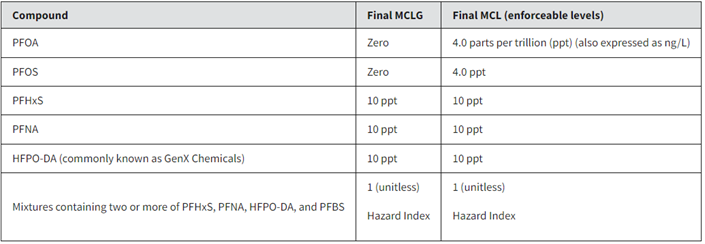On April 10, 2024, the U.S. Environmental Protection Agency (EPA) announced the final National Primary Drinking Water Regulation (NPDWR) for six PFAS. This is the first-ever national, legally enforceable drinking water standard designed to protect communities from exposure to harmful per-and polyfluoroalkyl substances (PFAS), also known as “forever chemicals.” According to the EPA, the final rule will reduce PFAS exposure for approximately 100 million people, prevent thousands of deaths, and reduce tens of thousands of serious illnesses.
This new regulation establishes legally enforceable levels, called Maximum Contaminant Levels (MCLs), for six PFAS in drinking water. The six PFAS are: PFOA, PFOS, PFHxS, PFNA, and HFPO-DA as contaminants with individual MCLs, and PFAS mixtures containing at least two or more of PFHxS, PFNA, HFPO-DA, and PFBS using a Hazard Index MCL to account for the combined and co-occurring levels of these PFAS in drinking water. The EPA also finalized health-based, non-enforceable Maximum Contaminant Level Goals (MCLGs) for these PFAS.
The final rule requires:
- Public water systems must monitor for these PFAS and have three years to complete initial monitoring (by 2027), followed by ongoing compliance monitoring. Water systems must also provide the public with information on the levels of these PFAS in their drinking water beginning in 2027.
- Public water systems have five years (by 2029) to implement solutions that reduce these PFAS if monitoring shows that drinking water levels exceed these MCLs.
- Beginning in five years (2029), public water systems that have PFAS in drinking water which violates one or more of these MCLs must take action to reduce levels of these PFAS in their drinking water and must provide notification to the public of the violation.
The EPA estimates that between 6% and 10% of the 66,000 public drinking water systems subject to this rule may have to take action to reduce PFAS to meet these new standards. The agency has also published a toolkit of communications resources to help drinking water systems and community leaders educate the public about PFAS, where they come from, their health risks, how to reduce exposure, and about this rule.
The EPA is holding three informational webinars for communities, water systems, and other drinking water professionals about the final PFAS rule.
- April 16, 2024 (2-3pm) Webinar Registration: General Overview of PFAS NDPWR for Communities
- April 23, 2024 (2-3pm) Webinar Registration: Drinking Water Utilities and Professionals Technical Overview of PFAS NPDWR
- April 30, 2024 (2-3:30pm) Webinar Registration: Small Drinking Water Systems Webinar Series on Final PFAS NPDWR and PFAS Drinking Water Treatment
For more information on the final rule and to access other supporting materials, click here.
VACo Contact: James Hutzler


